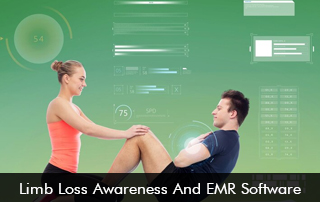Losing a limb is a life-altering experience, impacting individuals physically, emotionally, and psychologically. Limb loss can result from various causes, including accidents, medical conditions, or congenital factors. As we observe Limb Loss Awareness Month, let’s take a look at EMR software and how it revolutionizes the care and rehabilitation journey.
Understanding Limb Loss
Limb loss refers to the removal of a limb due to injury, disease, or a congenital condition. It can affect people of all ages and backgrounds, presenting unique obstacles to mobility, independence, and quality of life. Common causes of limb loss include traumatic accidents, vascular diseases like diabetes, cancer, and congenital disabilities.
Challenges Faced by Amputees
The loss of a limb introduces numerous physical and emotional hurdles for individuals. Adjusting to life with limb loss involves learning to navigate mobility aids, managing daily activities, and coping with the psychological impact of the loss. Additionally, amputees often encounter barriers in accessing comprehensive healthcare, prosthetic devices, and rehabilitation services.
The Role of EMR Software
Electronic Medical Record (EMR) software plays a pivotal role in addressing the complex needs of amputees and improving their overall healthcare experience. EMR systems offer a centralized platform for healthcare providers to securely store, manage, and exchange patient information, enabling seamless coordination of care across various medical specialties.
How EMR Software Enhances Limb Loss Awareness
Comprehensive Patient Profiles
EMR systems capture detailed patient profiles, including medical history, diagnostic imaging, surgical procedures, and prosthetic prescriptions. This comprehensive documentation ensures that healthcare providers have a holistic understanding of each amputee’s unique needs and treatment requirements.
Coordinated Care
Amputees often require multidisciplinary care involving orthopedic surgeons, physical therapists, prosthetists, and mental health professionals. EMR software facilitates seamless communication and collaboration among these healthcare stakeholders, ensuring that treatment plans are tailored to individual patient goals and preferences.
Proactive Monitoring
EMR systems enable healthcare providers to monitor amputee patients proactively, tracking their progress, functional outcomes, and prosthetic usage over time. By leveraging data analytics and reporting functionalities, clinicians can identify trends, anticipate complications, and intervene promptly to optimize patient outcomes.
Personalized Rehabilitation
Rehabilitation is a crucial component of the limb loss journey, empowering individuals to regain independence and maximize their functional abilities. EMR software supports personalized rehabilitation programs by documenting therapy sessions, tracking mobility milestones, and adjusting treatment protocols based on real-time progress assessments.
Prosthetic Management and EMR Software
Managing prosthetic devices requires careful evaluation, fitting, and ongoing adjustments to ensure optimal comfort and functionality for amputees. EMR systems streamline the prosthetic management process by documenting socket modifications, component upgrades, and maintenance schedules, facilitating timely interventions to address prosthetic-related issues.
Patient Education and EMR Software Support
Limb loss can be overwhelming for patients and their families, necessitating ongoing education and support throughout the rehabilitation journey. EMR software serves as a valuable resource for delivering educational materials, instructional videos, and community resources to empower amputees with the knowledge and skills they need to thrive.
Research and Innovation
EMR data repositories contribute to advancing limb loss research and innovation by facilitating retrospective studies, outcome analyses, and clinical trials. By anonymizing and aggregating patient data, researchers can identify best practices, develop evidence-based guidelines, and drive continuous improvement in amputee care.







